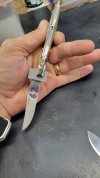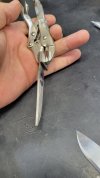There's only so much that can be said. Grinding is a skill that must be developed and maintained. If work prevents me from grinding for more than a week or two, I don't just jump back onto a project that is close to finished. I'll rough grind a couple new pieces to get the feel back.
In general if you are looking at a partially ground bevel, and you see where you want to remove material or straighten things, the trick is getting onto the bevel smoothly in an easy location, getting over to where you need to work without doing anything along the way, then grinding a little where you need to, and getting off. Then look closely at what was achieved and then make another pass. You will develop a sense of what caused small unintended things and slowly find that you can more directly get at what you want.





